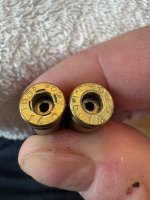That's what I was thinking. I'm a mediocre shot when shooting from the type of positions used in PRS. I think this quick and dirty session shows that under most circumstances this gun/ammo combination is going to be more accurate than I am.
I'm looking forward to bumping up the powder and setting COAL correctly and seeing what it will do.
I live in MA and the longest I can shoot is 300 yards. Over Columbus Day weekend I'll be up at my place in NH where I have 35 acres and can shoot 800 yards. I'm hoping to have a semi-final load made and entered into my Kestrel.
I'm looking forward to bumping up the powder and setting COAL correctly and seeing what it will do.
I live in MA and the longest I can shoot is 300 yards. Over Columbus Day weekend I'll be up at my place in NH where I have 35 acres and can shoot 800 yards. I'm hoping to have a semi-final load made and entered into my Kestrel.


